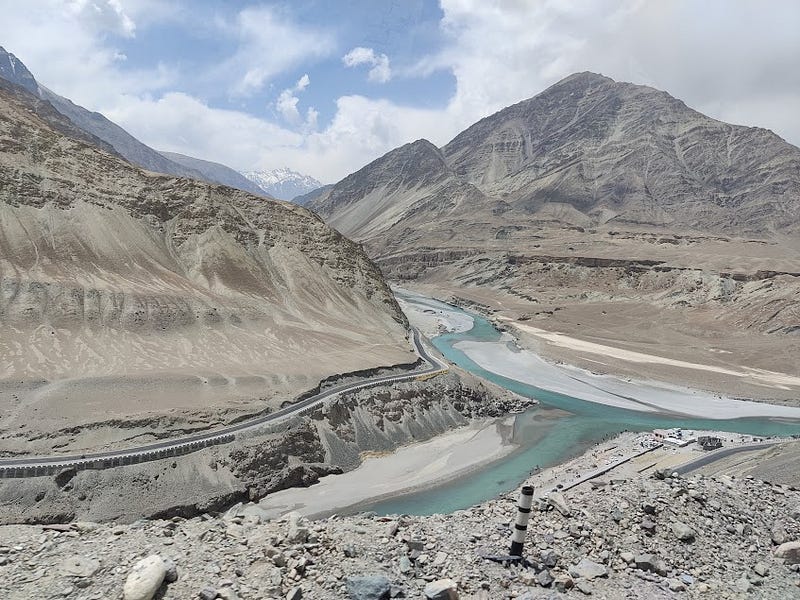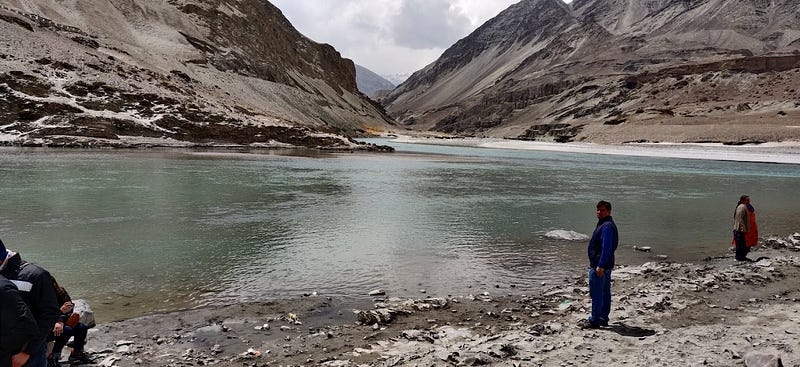
The day we reached Leh, Nono, our tour guide had asked for our identity proofs. He said he needed it to get an inner line permit. There are certain restricted places in Leh such as Kargil, Pangong, Nubra, Changla Pass, Khardung La pass and others which require an inner line permit due to security reasons. These Permits are issued by the Deputy Commissioner’s Office in Leh. Nono told us that he would take it for our visit to Pangong and Changla Pass
The roads after the magnetic hills were wide and well laid. Niyas played Peppy Hindi songs to cheer us up. I was feeling much better as we went downhill. The roads were getting busier with tourists touring. We had also met a few ladies working for the taxi controllers. A young girl in trousers and a jacket ran towards our car waving her hand high up. Two more women stopped the cars. They said something musically in the local language. Niyas kept saying something that sounded as if he was trying to convince them regarding the permit issued and stamped by the Indian authorities. Nono shared the permit on his mobile phone with Niyas. After showing the details, we were allowed to proceed.
How safe is it for women to work here? I asked Niyas.
Niyas commented, “It’s an equal opportunity place, and it’s safe for women. There has never been a crime or harassment of women”. There was great pride while expressing this.
Our journey after the Magnetic belt was a relaxing one. The mountains looked like huge sand dunes with a constant sandy breeze blowing from them. Niyas said that the road led to the Kargil district and the town. Kargil is the joint capital of Ladakh, which is now a union territory. When we arrived at the Gurudwara, we wanted to visit the meditation centre, but the ground was filled with army personnel waiting for high command. There was a long line of devotees waiting to visit the Gurudwara. The civilians were allowed to move ahead. There was a mobile tap system for washing hands and a small waterway for cleansing our feet before we reached the main sanctum. The army was paying their homage. They also helped the people and rendered their services to the cause. They provided a rumāl, a piece of clothing similar to a handkerchief or bandana to everyone who had forgotten theirs. I had my white dupatta with which I covered my head.
We were gradually led to the shrine where we prayed. We were also led to a cave-like structure that had a hollow rock shaped like the back of a person. Upon returning, we were greeted by army personnel with Prasad, the holy food offered during worship. We witnessed thousands of people pay their reverence as it was Khalsa day, Khalsa is a community that considers Sikhism as its faith and has a special group of initiated Sikhs. Guru Gobind Singh, the Tenth Guru of Sikhism, began the tradition in 1699 which marked a turning point in the history of Sikhism.
Niyas stood waiting for us near the car. He was fasting as it was the holy month of Ramadan. We observed people climb a mountain on the opposite side. Niyas said they were climbing to see the place where the demon had lived. We looked at him puzzled. He said, ‘Long ago there was a demon living on this mountain who devoured any human who climbed it. One had to climb the mountain to reach the hills nearby and cross the mountain.
Guru Nanak is thought to have rested and meditated on this mountain when he returned to Punjab via Srinagar in 1515–18, after visiting Sikkim, Nepal, and Tibet. The demon tried to kill Guru Nanak hauling a large boulder as he sat meditating. The boulder sped up as it tumbled down the hillside, but when it came in contact with Guru Nanak’s body, it softened like warm wax. The Guru continued to meditate, unhurt and undisturbed. The demon was taken aback to see the Guru deep in meditation when he came down. Angry, he tried to push the boulder with his right foot, but since the boulder was still soft, his foot got embedded in it. A foot impression of the demon can be seen on the boulder in Gurudwara, which has taken the shape of a meditating Guru Nanak in its hollow. Seeing the Guru’s spiritual power, the demon realized his powerlessness. The visitors climbed the hill, and they also visited the meditation centre. It was lunchtime for the devotees, and the peaceful place had suddenly become crowded.

We then reached the confluence of the Indus and Zanskar rivers. Niyas drove slowly and kept asking if I was feeling better. The confluence was downhill in Leh yet was situated at a height of more than 13000 feet above sea level in the valley named Nimmu. Some called the valley Zanskar, it is semi-arid and lies nestled in the great Himalayas. The rivers pass through a gorge which is spectacular with the dry mountains and blue-green water. This valley is about 105 km from Leh and is famous for adventure sports like trekking, paragliding, and water rafting, among others. People dropped money and sat on the banks of the confluence to experience the tranquillity. There was a small rest house with a few monuments a little away. The magnificence is beautiful during the short visits, but it must be hard to live without a lot of water and greenery in a landlocked cold desert of this kind. Niyas showed us the road to Nubra Valley passing through Khardung La pass. He said it was greener and the Nubra river was actually the Siachen river. The journey was long and we would have to go via Kargil. Our permits were in place but we weren’t prepared to go far.
In the evening we visited the Tibetan market. This market was a narrow lane with numerous shops on both ends yet it had banks, the bigger supermarkets and the good restaurants too. The shops however were spacious in the interiors. We found a place which sold jewellery, Tibetan handicrafts like Buddha statues, Prayer Bells, Thangka Paintings, Tibetan Trinkets, Singing Bowls, Choktse (carved wooden tables painted in colours), Prayer Flags, Prayer Wheels, key chains, fridge magnets with Leh Ladakh pictures and many others. He was a one-man army who wasn’t interested in the propaganda of his products. He was happy earning what he got from the visiting customers.
We felt better that day. The following day we visited the village early in the morning. We walked a bit and didn’t feel headaches or dizziness anymore. We were scheduled to travel to Delhi that afternoon. We admired the snow-peaked mountains and the hills to the core. The warmth of the early morning sunshine spoke that I had got acclimated to the weather and the simplicity of the people.
Nono drove us to the airport. He regretted that we weren’t able to enjoy some more time at Leh. He kept saying, “Next time, please plan a visit to Srinagar and Kashmir. You will not suffer from altitude sickness and I will make it a memorable trip”. I smiled, saying “Olay Olay Olay”
Comments
Post a Comment